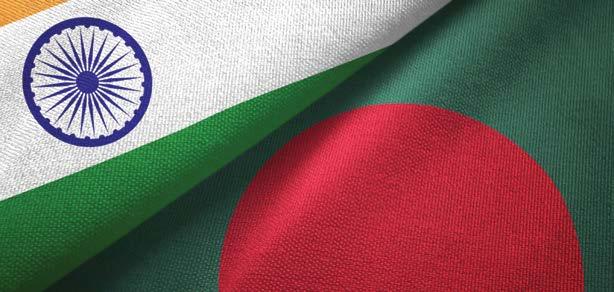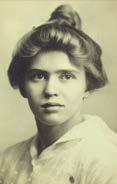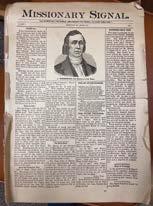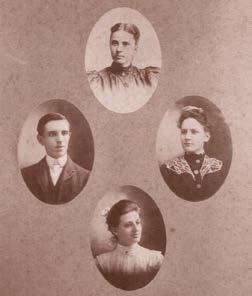
5 minute read
125 Years in India & Bangladesh: A Legacy Worth Celebrating!
by Dr. Robert Guy, Jr.
[What follows is an excerpt of an oral presentation from Dr. Robert Guy, Jr. at the Bangladesh 125th Celebration Ceremony in October of 2023. Here, Dr. Guy provides a clear throughline from the foundation of the Churches of God to the foundation of the Bangladesh (and India) mission to an audience of Bengali pastors, wives, children, and the mission/ hospital staff, who are less exposed to the early history of the Church of God.]
John Winebrenner and the Church of God had a missionary thrust from the very beginning. While our involvement in global missions was decades in the making, it sprang from the same roots that led the Churches of God to spread quickly across most of the Midwest.
The proclamation of the gospel and the outreach into new communities which characterized the first generation of the Church of God led to the creation of new elderships, or conferences; Ohio in 1836, West Pennsylvania in 1844, Indiana in 1846, Iowa in 1848, Michigan in 1850, and Illinois in 1851.
It is also important to note the influence of the Mennonite communities drawn into the Churches of God in those early years. Drawn to Winebrenner’s emphasis on the practical living of the faith, Mennonite communities brought a wholistic emphasis on caring for people, one that would find expression in medical work, and education, and in community development, all of which remain an active part of our Bangladesh and India ministry to this day.
Peter Loucks, who served as editor of the Workman Quarterly (published by the CGGC from 1879-1995), regularly pressed for the Church of God to launch its own educational institution as well as become involved in
missionary outreach in other countries. Though he did not live to see it realized, his son, Erastus Loucks, and nephew, Clifford Fox, were instrumental at Findlay College in its early days, and his granddaughter, Linna Louise Loucks Eckert, serves as one of our early missionary nurses.

Any history of Church of God missions should also accent the prominent role that women have played in our missionary endeavors from the very beginning! It is noteworthy that among our early missionaries was Daniel Wertz, who was married to Martha Beecher, the first woman ordained in the churches of God in 1858. This mission couple settled in Iowa, a conference that featured prominently in launching our foreign mission work.
John R. H. Latchaw, the first president of Findlay College, was also a driving force in preparing to support and send our first foreign missionary. Latchaw had also been raised in the Iowa Conference, and while there had been much discussion about foreign mission work, it was not until 1884 that a viable option appeared in conjunction with the Free Baptist Foreign Mission Board. Recognizing this as “our opportunity,” Latchaw called for a “united effort” across the Churches of God.
This led to a concerted effort across the various conferences. Following Latchaw’s lead, and responding to his appeal to raise funds, several conferences, from East Pennsylvania to Iowa, created missionary societies and began fundraising, with women taking a leading role. In 1890, the Women’s General Missionary Society was created, whose goal was to promote missions to the churches, to curate sustained giving toward missions work and missionaries, to publish and send out missionary news and information, and to send representatives to eldership meetings. Likewise, the organization of missionaries was entirely handed over to the WGMS for a time.

In 1896, The Missionary Signal was first published at the Barkeyville Academy in the West Pennsylvania Eldership, which began telling the stories of John Winebrenner and the early Church of God missionaries as a means of re-casting their missionary vision.

Also in 1896, the Churches of God finally sent its first missionary, Clara Landes, who was educated at Findlay College and ordained in the Iowa Conference. After two years of training at the Free Baptist Mission in Midnapur, she was appointed to Ulubaria, in the Howrah District of India, about twenty miles from Kolkata (Calcutta).
The Free Baptist Mission, whose work in India began in 1793, was delighted to partner with the Churches of God, as they had been struggling to find missionaries for the fields they had opened. In working with the Free Baptists, the Churches of God Mission anchored its ministry in the work of the celebrated missionary, William Carey, and to the very dawn of the modern mission work.
A few years later, Viola Hershey, who also studied at Findlay College, was selected by the East Pennsylvania, and A. C. Bowers by West Pennsylvania, as the second set of missionaries, and were sent to India in 1902. The Free Baptist Mission identified the region of Bogura (Bogra) as their field.

Both of these regions presented an abundance of opportunities for the missionaries, whose work from the beginning reflected the wholistic approach to ministry, including outreach, teaching, medical clinics, and community development.
Two particular aspects are noteworthy. The first involved the engagement with various tribal peoples who had been largely neglected in India, a work that continues to this day. The second was distinctly women’s work, which involved an intentional ministry with upper class (zenana) women who were otherwise entirely inaccessible. Both of these works yielded an abundance of fruit and are directly responsible for the long-lasting effect of our ministry in India and Bangladesh.










